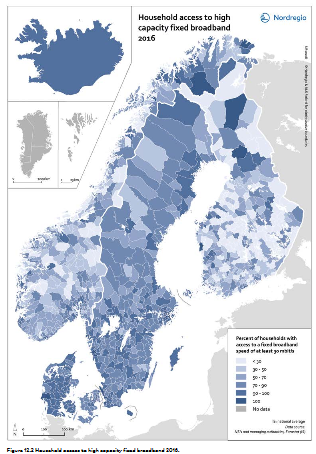The State of the Nordic Region report is published every second year, presenting the development in the Nordic countries and regions through statistics, maps, and analysis. It also places the Nordic region in a European context. Below, we present some of the results from the report’s two focus chapters on digitalisation and culture.
Highest share of fast broadband in Iceland and Denmark
The chapter on digitalisation takes off from the EU 2020 target of achieving fast broadband for all households in Europe, and examines the Nordic situation.
Of the Nordic countries, Iceland and Denmark lead the way with almost total coverage of fast broadband (around 95 per cent of each country’s population). Norway and Sweden, with 80 per cent coverage, are above the European average of 76 per cent, while Finland is just under with 75 per cent.
Household access to high capacity fixed broadband 2016

Source: State of the Nordic Region 2018 (p. 165)
The differences between the Nordic countries are best explained by variations in geography, i.e. the size of the country, and by the concentration of their populations to the largest urban areas.
The Nordics are major cultural consumers
The chapter on culture concentrates on cinema, libraries, and museums. The data show, for instance, that Icelanders are the most frequent cinema visitors in the Nordic region, and that Finns are the most frequent library visitors. Three of the Nordic country capitals – Helsinki, Stockholm, and Copenhagen – are also the capitals of library visits.
Eva Harrie
